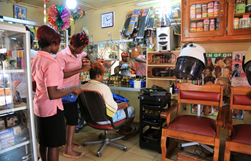Context
Togo has a significantly youthful population with 60% under the age of 35 years. The unemployment rate for this group is high at 22.8%. Moreover, the policy of free primary education has helped the country to reach a high enrollment of 90% in primary schools but many drop out of the formal educational system after primary school. The Togolese government set up the Basic Development Support Program (PRADEP) to support those with a minimum level of primary education to carry out business projects in order to create jobs for themselves.
Implementation of programme/ initiative
PRADEP is a five-year government program that began in January 2013 under the Ministry of Grassroots Development, Crafts, Youth and Youth Employment. The overall objective of this national program is to contribute to the reduction of youth unemployment. It aims to realize this objective through the following interventions:
- conducting training and seminars raising young people’s awareness of the potential for entrepreneurship;
- training young project leaders in the creation and management of micro-enterprises;
- facilitating access to credits, mainly by providing loans based on business plans;
- supervising and monitoring.
Participation in the program is open to young people who have at least a primary school certificate. PRADEP is financed by the government of Togo and the West African Development Bank with a budget of USD 14,201,000.
Main challenges
The activities of PRADEP focus on the primary sector; that is, agriculture, crafts and trade. The greatest challenge access to markets for products. To address this, PRADEP trains participants in market negotiation and has further set up the Togo Purchasing Centre for Young Entrepreneurs (CAJENT) to promote “Made in Togo” products and facilitate access to markets for the young entrepreneurs.
The other challenge is the low skill sets of applicants which is evident in the projects they submit. To raise participants’ skill levels, PRADEP organizes trainings for them, in partnerships with other organizations with similar goals.
Results
PRADEB has supported approximately 300 economic interest groups, mostly composed of women, and 700 microenterprises composed of young people. The supports have enabled women and young people to create jobs for themselves and others through access of microcredit to implement their businesses. In addition, 117 multifunctional platforms have been installed, enabling more than 170,000 beneficiaries to access modern energy for the implementation of their income-generating activities. To date, more than USD 8 million has been invested to support more than 5,000 young people and 15,000 women. Specifically, 637 young people got loans to launch their projects on the pillar “Youth Employment”. Loans were provided according to their business plans; and have received up to USD 5,000, which has created around 8,000 jobs. The loan is repayable over a maximum period of 36 months.
Moving Forward
This program can be sustained over the long term by exploring the following:
- revising the education system to ensure a match between the curricula and the country’s employment situation;
- diversifying funding sources for PRADEP by focusing on internal sources to minimize the impact of external shocks on the achievement of targets;
- conducting regular capacity building for both participants and the implementing body.
Replicability
The project is easily replicable in other countries, with adequate funding. The replicability of PRADEP will be greatly helped by organizing international meetings to share experiences and networking young people to share their own experience.
| References | Amouzou, E. A. (2012). Etude diagnostique de référence sur la situation de l’emploi des jeunes au Togo. Lomé : Ministère du développement à la base & Banque Africaine de Développement.
https://www.ituc-africa.org/IMG/pdf/22-Situation_du_marche_du_travail_Togo.pdf http://www.caderdt.com/wp-content/uploads/2013/12/Etude-Emploi-des-Jeunes.pdf |
Project Details
Date: November 20, 2017
